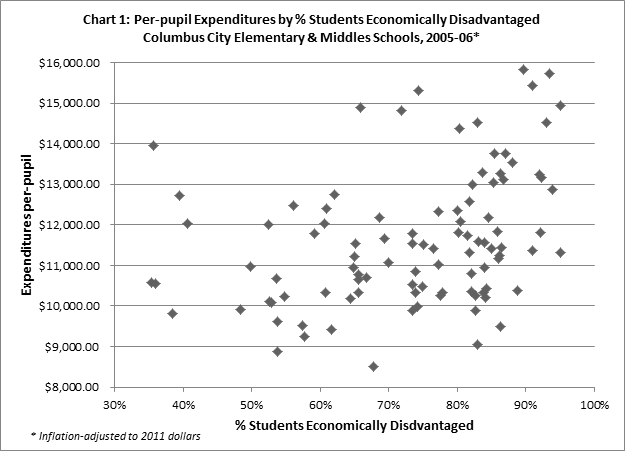Columbus City Schools are on the path to putting a property-tax levy on the November ballot (though it’s not a done deal; a citizen’s advisory committee will make its recommendation regarding a levy to district leaders next week and an official decision will follow). District officials say they need $355 million to maintain current programs, and to fund new initiatives, through the 2016-17 school year. Superintendent Gene Harris has indicated that the increase is needed, in part, because the district’s students are increasingly challenged – more kids are living in poverty, learning English, and disabled than in the past. Kids are also moving more frequently within, and to and from, the district.
Aside from a few big-ticket items (like sharing local tax dollars via grants with high-performing charter schools, increasing reading intervention in fourth and fifth grades, and purchasing new school buses), the district hasn’t detailed if, and how, it might alter its overall spending patterns if the levy passes. In the meantime, we can look at how the district is spending money today versus a few years back, for clues.
Charts 1 and 2 show per-pupil spending for Columbus’s elementary and middle schools against the percent of students in each school who were economically disadvantaged for the 2005-06 and 2010-11 – the most recent year for which data are available—school years (2005-06 dollars are adjusted for inflation to reflect 2011 values).[1]


Source: Ohio Department of Education PowerUsers reports
What do the charts tell us?
Demographics: Students are more economically disadvantaged in 2011 than they were in 2006.
- The district’s economically disadvantaged students made up 74 percent of total enrollment in 2006 and 82 percent five years later (ranking Columbus eighth statewide in terms of the percent of such students, behind Akron, Cleveland, Dayton, East Cleveland, Lorain, Mansfield, and Youngstown).
- Today 42 Columbus elementary and middle schools serve student populations in which more than 90 percent of students are economically disadvantaged; five years ago just ten schools served such a population.
Spending: Spending has increased slightly, but it isn’t clear that increases are focused on students who need it most.
- The average per-pupil spending for elementary and middle schools increased over five years by about 10 percent, or $1,200, to $13,500.
- No elementary or middle school is spending less than $10,000 per student today; when accounting for inflation, 13 were in 2006.
- Large gaps in spending levels between schools that serve similar populations existed in 2006 and were still present in 2011. Take schools in which more than 90 percent of students are economically disadvantaged:
- In 2006, spending ranged from $15,736 at Weinland Park Elementary (where 75.4 percent of students were disadvantaged and the school was rated Academic Emergency by the state) to $11,308 at Starling Middle School (97.3 percent disadvantaged, also rated Academic Emergency), a gap of $4,400.
- Today that gap is $5,700. In 2011 Starling Middle School (now 96.5 percent of students disadvantaged, rated Academic Watch) spent $15,877 per pupil, while West Mound Elementary (94.4 percent disadvantaged, rated Continuous Improvement) spent $10,176 per student.
There is also no clear relationship between school performance and spending. In 2011, the top-achieving Columbus elementary or middle school, Clinton Elementary, spent $13,928 per student – about $2,000 more than the lowest-achieving school, Fairwood Alternative Elementary, spent $11,560. Yet spending across the district doesn’t mirror such a pattern. Other high performers spend less, or only slightly more, than Fairwood; and low-performers are spending more than their high-performing peers. Similarly, there is no apparent relationship between spending and the percent of students who are English language learners, have special needs, or are highly mobile.
Alex Fischer, CEO of the Columbus Partnership and a member of the levy advisory committee, encourages the district to seek “transformational change” as part of its levy request. Moving toward a system where per-pupil spending is based on students’ educational challenges and follows kids to the school they attend would certainly be such a change. Columbus’s students are more disadvantaged than they were five, or ten, years ago. The district acknowledges this reality and that more money may need to be directed to students who need it most. Current spending patterns show that the district isn’t systematically directing more dollars toward neediest students today, but such a shift – to a student-based funding model (aka weighted-student funding) – could be made, and should be considered, along with passage of a levy.
[1] Schools that serve a very high population of special needs students and the district’s “welcome centers” – which serve as a transition program to help newly arrived immigrant students build basic English and academic skills – have been removed from this analysis.
